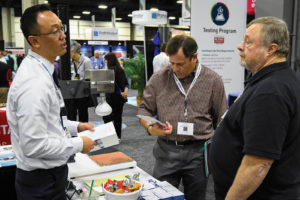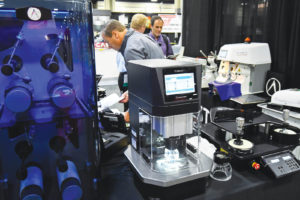
IFAI’s Advanced Textiles Conference: Testing Program 2017
At the 2017 Advanced Textiles Conference (ATC), four educational tracks—military, medical, smart fabrics, and testing—will give attendees the latest news on the processes, products, and profit potential in working with high-tech fabrics and fabrication techniques. ATC, part of IFAI Expo 2017, will be held in New Orleans, La., from Sept. 26–29.
This year’s ATC Testing Program, offered in cooperation with North Carolina State College of Textiles and supported by the Association of Textile, Apparel, and Materials Professionals (AATCC), gives attendees the opportunity to earn the Intro to Testing Certificate and to advance to the more comprehensive Textile Testing Essentials Certificate.
The Intro to Testing Certificate seminar provides the basics of textile testing: understanding current testing methods and how and where they apply, how to determine the difference between standard and nonstandard testing, identifying performance specifications and how they help to define your product, and how to find resources to answer your textile testing questions. For a list of the requirements necessary to earn this certificate at IFAI Expo/ATC, visit http://ifaiexpo.com/testing.

The Textile Testing Essentials Certificate educational track at ATC is designed by North Carolina State to equip participants with the tools to make better decisions based on textile properties by learning both the methodology and interpretation of standard test procedures. This certificate can be used as credit toward the North Carolina State Textile Technology Certificate Program. For a list of the requirements needed, visit www.ifaiexpo.com/testing.
Come to the Testing Demo Zone on the show floor to interact with experts and see the latest testing equipment firsthand, with live demonstrations, question-and-answer sessions, and videos on current research, testing, and product development.
For complete program information on IFAI’s Advanced Textiles Conference, visit www.ifaiexpo.com/schedule/advanced-textiles-programming.
2017 ASCE Report Card makes strong case for greater infrastructure investment
The American Society of Civil Engineers (ASCE) released it’s 2017 Infrastructure Report Card this spring, and it offers the nation both bad news and good news.
The bad is the average grade, D+, has not changed since the last report card four years ago, reflecting a continued dire need of overhaul.
The good news is the report card says such an overhaul is still attainable and offers suggested solutions that can make that overhaul happen.
“There are reasons for optimism because . . . we’ve proposed some very real solutions,” said ASCE 2017 president Norma Jean Mattei, Ph.D., P.E., F.SEI, F.ASCE. “So, the grade is bad, but the good news is we’ve got the [Trump] administration and members of Congress that ran on campaign promises [of] fixing infrastructure. It’s a priority.”
While the overall infrastructure grade remains unchanged since 2013, seven of the 16 infrastructure categories assessed did see improvement, including hazardous waste, inland waterways, levees, ports, rail, schools, and wastewater.
Rail received the highest category grade, earning a B. Transit, meanwhile, received the lowest, a D–.
A team of 28 civil engineers from across the country with decades of expertise in all 16 categories prepared the report card. ASCE’s Committee on America’s Infrastructure (CAI) amassed and assessed all relevant data and reports, consulting with technical and industry experts, and assigning grades using the following criteria: capacity, condition, funding, future need, operation and maintenance, public safety, resilience, and innovation.
Now, to those solutions.
The Infrastructure Report Card recommends three key steps toward raising the grades. Greg DiLoreto, P.E., P.L.S., D.WRE, Pres.13.ASCE, former ASCE president, and current chair of the CAI team that assembled the report card, laid out the solutions at the release event: “We are underfunded in our infrastructure, so the No. 1 solution is that we have to increase our investment in infrastructure, and we have to do that at all levels—at the federal, at the state, and at the local level. It has to be increased. We need our elected officials to be leaders and say, ‘This is really important,’ and we need the American public to say, ‘This is important.’
“We [also] have to look at how we do these projects as engineers. We need to build them sustainably, and we need to build them resilient. We need to look at the total life of that project, from the day we put a shovel in the ground until the day we retire that project—a cradle-to-grave approach in how we do this.”
Investment, leadership, preparation for the future. Each is intertwined with the other, but it all starts with money.
As former Pennsylvania Gov. Edward G. Rendell said during the release event’s panel discussion, “The key is investment, there’s no getting around it.”
ASCE estimates that the nation’s infrastructure needs a total of $2 trillion across the 16 categories through 2025. The report card estimates that a failure to invest—what Rendell called “the cost of doing nothing”—would cause a $3.9-trillion decrease in the gross domestic product by 2025, $7 trillion in lost business sales by 2025, and $2.5 million in lost income for employees by 2025.
Joining Rendell on the panel were Drew Greenblatt, CEO of Marlin Steel Wire, who made the business case for infrastructure spending, and DC Water CEO George Hawkins, who talked about the value of innovation and forward thinking when it comes to building the next generation of utilities and infrastructure. Connecticut Gov. Dannel Malloy, who has pressed successfully for infrastructure investment in his state, also appeared at the release event and related various challenges and successes from his state’s perspective.
“As engineers, our members realize that we have an obligation to speak out on issues of public health, safety, and welfare. If we’re not, who is?” said ASCE executive director Tom Smith, ENV SP, CAE, F.ASCE. “And it’s really making a difference in terms of changing the conversation. I think now we just need to strike while the iron’s hot. There’s a lot of good discussion taking place on infrastructure. We’ve got to make sure we convert that to action with the new administration and Congress.”
Additional information regarding the report card, category grades, and state report cards and information, as well as infographics, videos, and other resources, can be found on http://www.infrastructurereportcard.org or via the Save America’s Infrastructure app in the Google Play and App Stores.
 TEXTILES.ORG
TEXTILES.ORG


